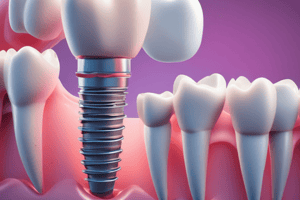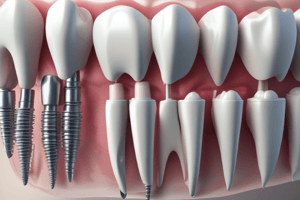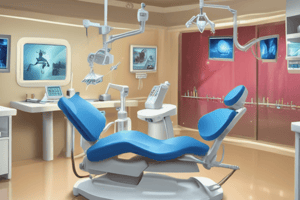Podcast
Questions and Answers
What is a key diagnostic sign of necrotizing periodontitis?
What is a key diagnostic sign of necrotizing periodontitis?
- Punched out, crater-like depressions at crest of interdental papilla (correct)
- Formation of periodontal pockets
- Gingival bleeding upon brushing
- Gingival swelling and redness
Which symptom is associated with necrotizing periodontitis?
Which symptom is associated with necrotizing periodontitis?
- Intermittent sharp pain
- No pain or discomfort
- Gradual onset with mild discomfort
- Abrupt onset with development of severe pain (correct)
What is a distinguishing feature of necrotizing gingivitis?
What is a distinguishing feature of necrotizing gingivitis?
- Gingival overgrowth
- Gingival recession
- Erosion of interdental papilla tip (correct)
- Formation of calculus
Which of the following is a symptom of necrotizing periodontitis?
Which of the following is a symptom of necrotizing periodontitis?
What is a common complaint related to necrotizing periodontitis?
What is a common complaint related to necrotizing periodontitis?
What is a distinguishing factor between necrotizing periodontitis and conventional periodontitis?
What is a distinguishing factor between necrotizing periodontitis and conventional periodontitis?
What medical conditions increase the risk of developing periodontitis?
What medical conditions increase the risk of developing periodontitis?
What is the initial treatment for necrotizing periodontitis?
What is the initial treatment for necrotizing periodontitis?
What can cause single severe bone defects around teeth, resembling localized severe periodontitis?
What can cause single severe bone defects around teeth, resembling localized severe periodontitis?
Which bacteria are thought to cause local tissue necrosis?
Which bacteria are thought to cause local tissue necrosis?
What is the initial treatment for herpetic gingivostomatitis?
What is the initial treatment for herpetic gingivostomatitis?
What is a typical trigger for an episode of necrotizing gingivitis affecting young adults?
What is a typical trigger for an episode of necrotizing gingivitis affecting young adults?
What happens if the implant platform is significantly facial to the ideal position?
What happens if the implant platform is significantly facial to the ideal position?
What is the initial treatment for gingival abscess?
What is the initial treatment for gingival abscess?
What can cause non-healing ulcers in the gingiva?
What can cause non-healing ulcers in the gingiva?
What is the initial treatment for toothpaste allergy?
What is the initial treatment for toothpaste allergy?
What are the clinical signs and symptoms of allergic reactions in the oral cavity?
What are the clinical signs and symptoms of allergic reactions in the oral cavity?
What happens if the implant platform is significantly apical to the CEJ of adjacent teeth?
What happens if the implant platform is significantly apical to the CEJ of adjacent teeth?
What drugs can cause lichenoid drug reactions in the oral cavity?
What drugs can cause lichenoid drug reactions in the oral cavity?
What is the initial treatment for necrotizing gingivitis?
What is the initial treatment for necrotizing gingivitis?
What is the initial treatment for endodontic abscess?
What is the initial treatment for endodontic abscess?
What tools are used in implant placement for specific purposes?
What tools are used in implant placement for specific purposes?
What are the clinical features of untreated abscesses?
What are the clinical features of untreated abscesses?
How can pitfalls in implant placement be avoided?
How can pitfalls in implant placement be avoided?
What is a potential consequence of type 2 diabetic patients undergoing implant treatment?
What is a potential consequence of type 2 diabetic patients undergoing implant treatment?
How can allergic reaction to toothpaste or mouth rinse present?
How can allergic reaction to toothpaste or mouth rinse present?
What is involved in the prevention of peri-implantitis in diabetic patients?
What is involved in the prevention of peri-implantitis in diabetic patients?
How should the platform be aligned in free-handed placement of a single ZimVie implant?
How should the platform be aligned in free-handed placement of a single ZimVie implant?
Flashcards are hidden until you start studying
Study Notes
Dental Care and Implant Placement: Detailed Summary
- Treatment for an oral lesion includes perio therapy, oral hygiene instructions, and dietary restrictions.
- Allergic reaction to toothpaste or mouth rinse can present with unilateral blisters, erythema, or white lesions.
- Clinical features of gingival, periodontal, and endodontic abscesses vary based on patient age, periodontal health, and tooth vitality.
- Untreated abscesses can cause pain, gingival swelling, and radiographic bone loss.
- Implant placement involves tools such as implant wrench, cover screw, and healing abutment for specific purposes during the procedure.
- In free-handed placement of a single ZimVie implant, the platform should ideally be aligned with adjacent teeth, at least 3mm from nearest tooth root surface, and parallel to the occlusal table.
- Pitfalls in implant placement, such as bone necrosis and drill getting stuck, can be avoided by using proper drilling techniques and preoperative assessment.
- Conditions like necrotizing gingivitis, periodontitis, and herpetic gingivostomatitis can be identified based on specific clinical features.
- Patients with type 2 diabetes undergoing implant treatment are more likely to experience peri-implantitis due to poor healing and inflammation.
- Prevention of peri-implantitis in diabetic patients involves controlling blood glucose levels and monitoring HbA1c before and after implant placement.
Studying That Suits You
Use AI to generate personalized quizzes and flashcards to suit your learning preferences.




